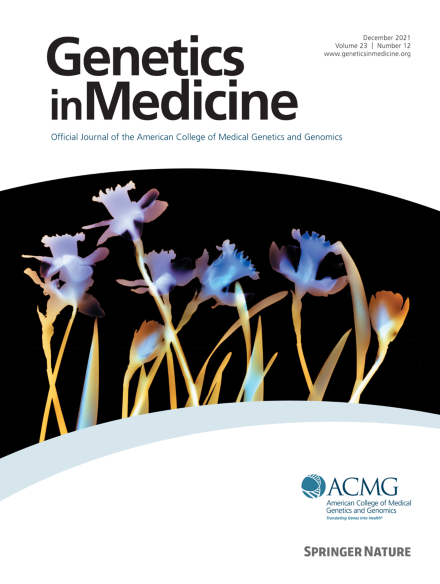杂合子种系DIS3L2变异体儿童Wilms肿瘤特征。
IF 6.2
1区 医学
Q1 GENETICS & HEREDITY
引用次数: 0
摘要
目的:杂合子种系DIS3L2致病变异最近与Wilms肿瘤(WT)易感性有关。关于癌症外显率和特征的有限数据使监测/管理建议复杂化。本研究旨在描述WTs和杂合种系(可能)致病性DIS3L2变异((L) pv)儿童的扩展队列。方法:回顾性收集儿童WT和杂合种系DIS3L2 (L) pv的临床和肿瘤资料。结果:共发现34例患儿,其中家族性病例4例。种系(L) pv包括外显子9缺失(n=28)和其他(n=6) (L) pv。17位父母被证实患有DIS3L2 (L)PV,其中1位曾经患有WT。WT诊断时的中位年龄为41个月(范围:8-101)。在19/20有遗传肿瘤数据的儿童中发现了DIS3L2的体细胞二次撞击。5例患儿有双侧WTs, 11例有转移(32%)。8例患儿存在高危肿瘤组织学(占24%,其中7例为化疗后囊胚)。3名儿童复发或发展第二原发肿瘤,4名儿童死亡。缺乏复发性临床特征。结论:WTs和杂合子种系DIS3L2 (L) pv患儿缺乏可识别的表型。DIS3L2 (L) pv是家族性WT的一个原因,但WT的外显率可能很低。该队列显示出高转移率和高危囊胚肿瘤,有待进一步研究。本文章由计算机程序翻译,如有差异,请以英文原文为准。
Wilms tumor characteristics in children with heterozygous germline DIS3L2 variants
Purpose
Heterozygous germline DIS3L2 pathogenic variants were recently linked to Wilms tumor (WT) predisposition. Limited data on cancer penetrance and characteristics complicate surveillance/management recommendations. This study aims to describe an extended cohort of children with WTs and heterozygous germline DIS3L2 (likely) pathogenic variants ([L]PVs).
Methods
Clinical and tumor data of children with WT and heterozygous germline DIS3L2 (L)PVs were retrospectively collected.
Results
Thirty-four children were identified, including 4 familial cases. Germline (L)PVs included exon 9 deletions (n = 28) and other (n = 6) (L)PVs. Seventeen parents were confirmed to have the DIS3L2 (L)PV, of whom 1 had a past WT. Median age at WT diagnosis was 41 months (range: 8-101). A somatic second hit in DIS3L2 was found in 19 of 20 children with genetic tumor data. Five children had bilateral WTs and 11 had metastases (32%). Eight children had high-risk tumor histology (24%, of which 7 post-chemotherapy blastemal). Three children relapsed or developed a second primary tumor; 4 children were deceased. Recurring clinical features were lacking.
Conclusion
Children with WTs and heterozygous germline DIS3L2 (L)PVs lack a recognizable phenotype. DIS3L2 (L)PVs are a cause for familial WT, but WT penetrance is likely low. This cohort exhibits a high percentage of metastases and high-risk blastemal tumors, which need further study.
求助全文
通过发布文献求助,成功后即可免费获取论文全文。
去求助
来源期刊

Genetics in Medicine
医学-遗传学
CiteScore
15.20
自引率
6.80%
发文量
857
审稿时长
1.3 weeks
期刊介绍:
Genetics in Medicine (GIM) is the official journal of the American College of Medical Genetics and Genomics. The journal''s mission is to enhance the knowledge, understanding, and practice of medical genetics and genomics through publications in clinical and laboratory genetics and genomics, including ethical, legal, and social issues as well as public health.
GIM encourages research that combats racism, includes diverse populations and is written by authors from diverse and underrepresented backgrounds.
 求助内容:
求助内容: 应助结果提醒方式:
应助结果提醒方式:


